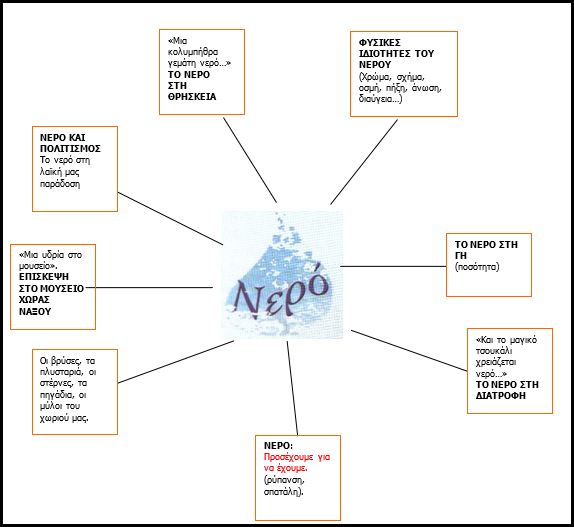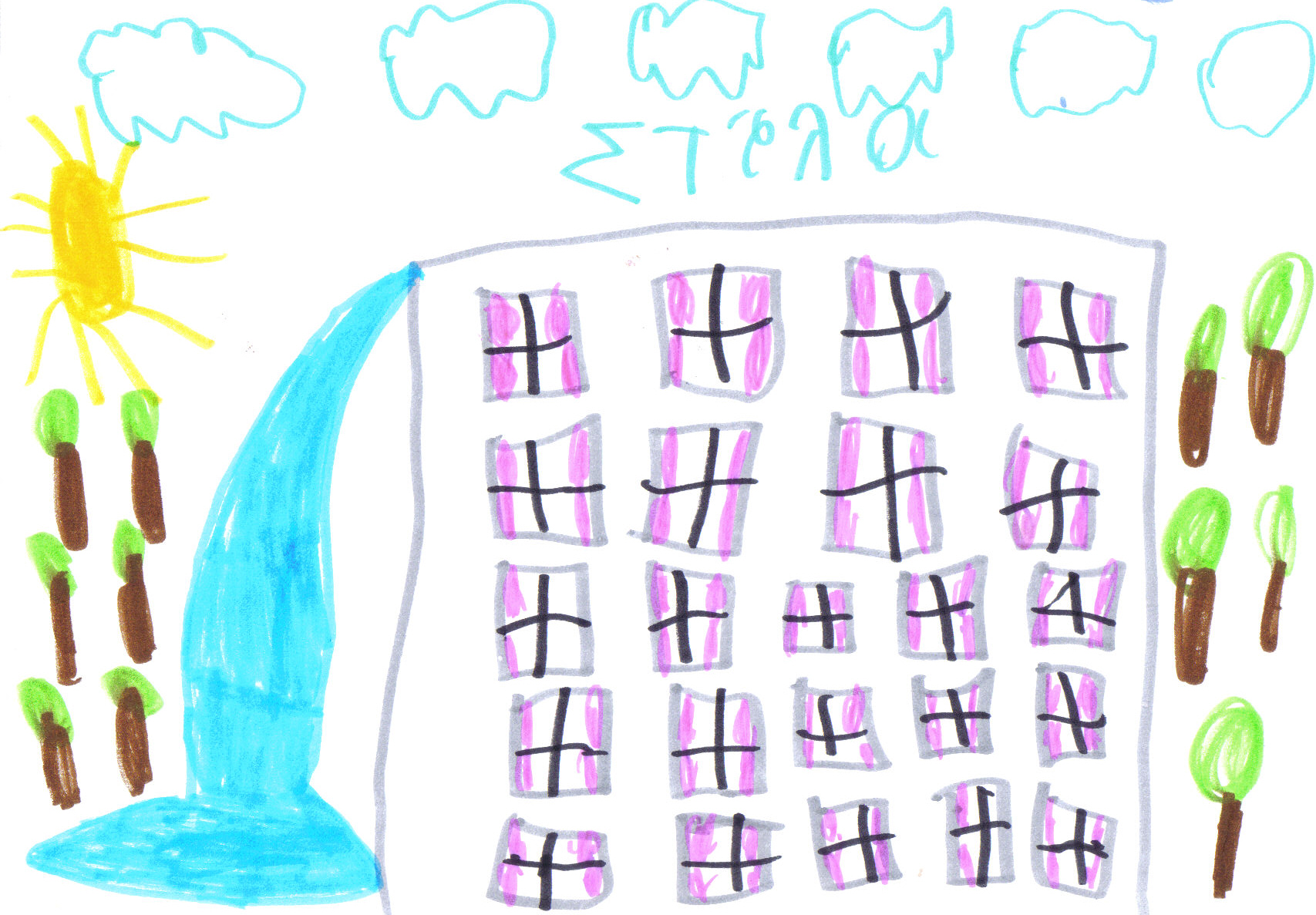General Info

Water is a topic familiar to all children. Their interest in learning more about this began with their hand washing before the tithe and the view of the rainbow in the sky after a sudden downpour in mid-October.
Sangri of Naxos is a village with manganese wells, windmills that are no longer used and fountains. After a short walk in Kato Sangri, we found that several traditional houses had a laundry room in their backyards that used to serve mainly for washing clothes, but also for house lovers.
All the above elements led to the decision to study water, approaching it with knowledge and information related to culture, arts, natural sciences, mathematics, language, technology. The main goal of the program was in addition to the knowledge and information that the children would gain, to raise issues of environmental protection and economy in water consumption, throughout the year and especially in the summer months due to the intense tourist traffic on the island.
Το νερό είναι ένα θέμα οικείο σε όλα παιδιά. Το ενδιαφέρον τους να μάθουν περισσότερα γι’ αυτό, ξεκίνησε με αφορμή το πλύσιμο το χεριών τους πριν από το δεκατιανό και η θέα του ουράνιου τόξου στον ουρανό μετά από μια ξαφνική μπόρα στα μέσα του Οκτώβρη.
Το Σαγκρί της Νάξου είναι ένα χωριό με μαγκανοπήγαδα, ανεμόμυλους που δεν χρησιμοποιούνται πλέον και βρύσες. Μετά από έναν μικρό περίπατο στο Κάτω Σαγκρί, διαπιστώσαμε ότι αρκετά παραδοσιακά σπίτια είχαν πλυσταριό στις αυλές τους που εξυπηρετούσε κυρίως παλαιότερα στο πλύσιμο των ρούχων, αλλά και στη λάτρα του σπιτιού.
Όλα τα παραπάνω στοιχεία οδήγησαν στην απόφαση να μελετήσουμε το νερό, προσεγγίζοντας το με γνώσεις και πληροφορίες που συνδέονται με τον πολιτισμό, τις τέχνες, τις φυσικές επιστήμες, τα μαθηματικά, τη γλώσσα, την τεχνολογία. Βασικός στόχος του προγράμματος ήταν εκτός από τις γνώσεις και τις πληροφορίες που θα αποκόμιζαν τα παιδιά, να τεθούν ζητήματα προστασίας του περιβάλλοντος και οικονομίας στην κατανάλωση του νερού, καθ΄ όλη τη διάρκεια του έτους και ειδικότερα τους θερινούς μήνες λόγω της έντονης τουριστικής κίνησης στο νησί.
Audience and Educational Framework
Educational Details

CONTENTS:
INTRODUCTION
- 1st unit: WATER IN RELIGION
"A swimming pool full of water…"
- 2nd Unit: WATER AND CULTURE
"Water in our folk tradition".
- 3th Unit: VISIT TO THE FOUNTAINS, THE WELLS, THE MANGAN WELLS AND THE MILLS OF OUR VILLAGE.
- 4th Unit: "A WATER IN THE MUSEUM".
Visit to the Archaeological Museum of Naxos Town.
- 5th Unit: "WATER: WE ARE CAREFUL TO HAVE".
Pollution-Waste.
- 6th Unit: WATER IN NUTRITION.
"And the magic owl needs water…"
- 7th Unit: PHYSICAL PROPERTIES OF WATER.
(Color, shape, smell, coagulation, buoyancy, clarity…)
- WAYS OF PRESENTATION OF THE RESULTS OF THE PROGRAM.
- EVALUATION.
- BIBLIOGRAPHY.
Evaluation throughout the program was a continuous and dynamic process, integrated within the program and not independent of it. In terms of its stages, it was in three phases and in terms of its role it helped in its feedback. It was a) Initially in accordance with the children's cognitive field, b) Formative according to the actions, questions, and interests of the children.
The ways of presenting the results of the program to the local community (advertising spot, summer event), the sketches, the works-constructions of the children, the surveys with questionnaires for the unnecessary use of water at home, are proofs that the goals of P. were achieved. E in the field of knowledge (third phase of evaluation - final).
The children started from what they already knew and through practical-experiential learning, they built new knowledge (constructivism) about water.
Η αξιολόγηση καθ΄ όλη τη διάρκεια του προγράμματος ήταν μια συνεχής και δυναμική διαδικασία, ενταγμένη μέσα στο πρόγραμμα και όχι ανεξάρτητη από αυτό. Ως προς τα στάδιά της ήταν σε τρεις φάσεις και ως προς το ρόλο της βοήθησε στην ανατροφοδότησή του. Ήταν: α) Αρχικά σύμφωνη με το γνωστικό πεδίο των παιδιών, β) Διαμορφωτική σύμφωνα με τις δράσεις, τα ερωτήματα και τα ενδιαφέροντα των παιδιών.
Οι τρόποι παρουσίασης των αποτελεσμάτων του προγράμματος στην τοπική κοινωνία (διαφημιστικό σποτ, καλοκαιρινή εκδήλωση), τα ιχνογραφήματα, τα έργα- κατασκευές των παιδιών, οι έρευνές με ερωτηματολόγια για την άσκοπη χρήση του νερού στο σπίτι, αποτελούν αποδείξεις ότι επιτεύχθηκαν οι στόχοι της Π.Ε στο γνωστικό τομέα (γ΄ φάση αξιολόγησης- τελική).
Τα παιδιά ξεκίνησαν από όσα ήδη γνώριζαν και μέσω της πρακτικο-βιωματικής μάθησης, οικοδόμησαν νέες γνώσεις (κονστρουκτιβισμός) για το νερό.
ΒΙΒΛΙΟΓΡΑΦΙΑ
- «Ο Νερούλης και ο Νερουλένιος», Νίκη Ψαράκη- Μπελεσιώτη, Μουσείο Μπενάκη-Εκπαιδευτικά Προγράμματα, Αθήνα 2001.
- «Η Γοργόνα», Ανδρέας Καρκαβίτσας, Εκδ. Παπαδόπουλος, Αθήνα 2000.
- «Το ταξίδι του νερού», Μαριόρας και Αθανάσιου Εξαρχόπουλου, Εκδ. Αίολος, Αθήνα 1988.
- «Νερό», από τη σειρά «Τα τέσσερα στοιχεία», Carme Sole Vendrell - J.M. Parrammon, Εκδ. Κέδρος.
- «Περιβαλλοντική Αγωγή για μικρά παιδιά», Δημοπούλου- Ζόμπολας-Μπαμπίλα-Χατζημιχαήλ, Εκδ. Καλειδοσκόπιο, Αθήνα 2001.
- «Ο χιονάνθρωπος που δεν ήθελε να λιώσει», Μάνος Κοντολέων, Αθήνα, Εκδ. Α.Σ.Ε.
- «Ταξιδεύοντας και Δημιουργώντας», Κωνσταντινίδου- Ματθαίου-Χαβιάρης, Εκδ. Ελληνικά Γράμματα, Αθήνα 1995.
- «Παιχνιδομαγειρέματα», Αγγελική Μαστρομιχαλάκη-Μαίρη Βούκανου, Εκδ. Ακρίτας-Παιδικά, Αθήνα 2002.
- «Ένας νερόμυλος στην Τζια», Γιώργος Σπέης-Κατερίνα Παλαιολόγου, Εκδ. Κέδρος, Αθήνα 2004.
- «Το σύννεφο που έβαλε τα κλάματα», Σοφία
- Μαντούβαλου, Εκδ. Καστανιώτη, Αθήνα .
- «Με τις κούκλες πίσω απ’ τη σκηνή», Βίκυ Κουλουμπή- Πάλμου, Εκδ. Ελληνικά Γράμματα.
- «360 Ελληνικά αινίγματα», Μαρία Μιχαήλ-Δέδε
- «Ελληνικά Αινίγματα», Φαίδων Τόγσκα, Εκδ. Μπαρπουνάκης
- «Αινίγματα με εικόνες», Ρούλα Παπανικολάου, Εκδ. ΜΙΚΡΟΣ ΠΡΙΓΚΙΠΑΣ.
- «Ελληνικά Παραδοσιακά Παραμύθια-Τα τρία αδέρφια και η πεντάμορφη του πηγαδιού», Διασκευή: Άννα Λαούταρη, Εκδ. Παρασκευαδάκη, Αθήνα 1991.
- «Ανθολόγιο Λογοτεχνικών Κειμένων για το νηπιαγωγείο», Υ.Π.Ε.Π.Θ-Παιδαγωγικό Ινστιτούτο, ΟΕΔΒ, Αθήνα 2000.
- «Τα πρώτα μου ποιήματα», Χάρης Σακελαρίου, Εκδ. Άγκυρα.
- «Δραστηριότητες για το περιβάλλον»,Φράνσις Μακκέϋ,Εκδ. Πατάκη, Αθήνα 1993.
- «Ένα κουτί γεμάτο νερό», Κουσκολέκα Νέλλη, Εκδ. Καλειδοσκόπιο, Αθήνα 1999.
- «ΝΑΞΟΣ-Τα μνημεία και το Μουσείο», Φωτεινή Ζαφειροπούλου, Εκδ. ΚΡΗΝΗ, Αθήνα 1988.
- «Μουσεία και Σχολεία, Δεινόσαυροι κι Αγγεία», ‘Αλκηστις, Εκδ. ΕΛΛΗΝΙΚΑ ΓΡΑΜΜΑΤΑ, Αθήνα 1995.
- «Βιωματική-Επικοινωνιακή Διδασκαλία, Η Εισαγωγή της Μεθόδου Project στο Σχολείο»,Χρυσαφίδης Κώστας, Εκδ.Gutenberg, Αθήνα 2000.
- «Εξελικτική Ψυχολογία», τόμ.2, Παρασκευόπουλος Ι., Αθήνα.
Software:Mind/Concept map, copywriter, video maker/editor
Implementation
(where and how the practice was implemented)

However, in terms of recruitment, it was observed that the children showed a willingness to watch in all phases of the program. They responded and this was shown through the willingness to actively participate (answers, help, worksheets, writing, crafts, research, field visits, mathematical approaches-quantity or comparisons).
The constant reminders in conversations with each other not to waste water unnecessarily when washing their hands at school or in the proper and not equitable use of water at home (according to the testimonies of the parents), the awareness of the whole society through advertising, proved that they valued water as a valuable commodity for man, valuing it positively and that they understood the difference between the concepts of waste-saving water and the consequences of its lack.
In the psychomotor field they willingly took part in the visits, enriched their vocabulary, engaged in experiments, working as a team or undertaking a specific type of action-role. At the end of the school year, they organized and presented to the society of their village a theatrical event, which was the essence of the knowledge, attitudes and values that the children gained from the implementation of the program.
Παρατηρήθηκε όμως όσο αφορά την πρόσληψη, ότι τα παιδιά επέδειξαν μια προθυμία παρακολούθησης σε όλες τις φάσεις του προγράμματος. Ανταποκρίθηκαν και αυτό φάνηκε μέσα από την προθυμία ενεργού συμμετοχής (απαντήσεις, βοήθεια, φύλλα εργασίας, γραφή, χειροτεχνικές εργασίες, έρευνα, επισκέψεις στα πεδία δράσης, μαθηματικές προσεγγίσεις-ποσότητα ή συγκρίσεις ).
Οι διαρκείς υπενθυμίσεις σε συζητήσεις μεταξύ τους να μη ξοδεύουν άσκοπα το νερό όταν έπλεναν τα χέρια τους στο σχολείο ή στη σωστή και όχι άλογη χρήση του νερού στο σπίτι (σύμφωνα με τις μαρτυρίες των γονέων), η ευαισθητοποίηση του κοινωνικού συνόλου μέσω της διαφήμισης, απέδειξαν ότι απέδωσαν αξία στο νερό ως πολύτιμο αγαθό για τον άνθρωπο, αποτιμώντας το θετικά και ότι κατανόησαν τη διαφορά των εννοιών σπατάλη-εξοικονόμηση νερού και τις συνέπειες από την έλλειψή του.
Στον ψυχοκινητικό τομέα πρόθυμα έλαβαν μέρος στις επισκέψεις, εμπλούτισαν το λεξιλόγιό τους , ασχολήθηκαν με πειράματα, δουλεύοντας ομαδικά ή αναλαμβάνοντας ένα συγκεκριμένο είδος δράσης-ρόλο. Στο τέλος της σχολικής χρονιάς οργάνωσαν και παρουσίασαν στην κοινωνία του χωριού τους θεατρικό δρώμενο, που αποτέλεσε το απόσταγμα της γνώσης, των στάσεων και των αξιών που τα παιδιά αποκόμισαν από την υλοποίηση του προγράμματος.
Educational material/resources (file/URL) accompanying the practice
English
Greek
| Attachment | Size |
|---|---|
| Questionaire.png | 136.28 KB |
English
The results of the research in the graph, show that children often wash their hands during the week, take a bath 2-3 times a week and some neglect brushing their teeth during the day and therefore during the week.
Τα αποτελέσματα της έρευνας στο γράφημα, αποδεικνύουν ότι τα παιδιά πλένουν συχνά τα χέρια τους κατά τη διάρκεια της εβδομάδας, κάνουν μπάνιο 2-3 φορές εβδομαδιαίως και κάποια παραμελούν το πλύσιμο των δοντιών κατά τη διάρκεια της ημέρας και συνεπώς της εβδομάδας.